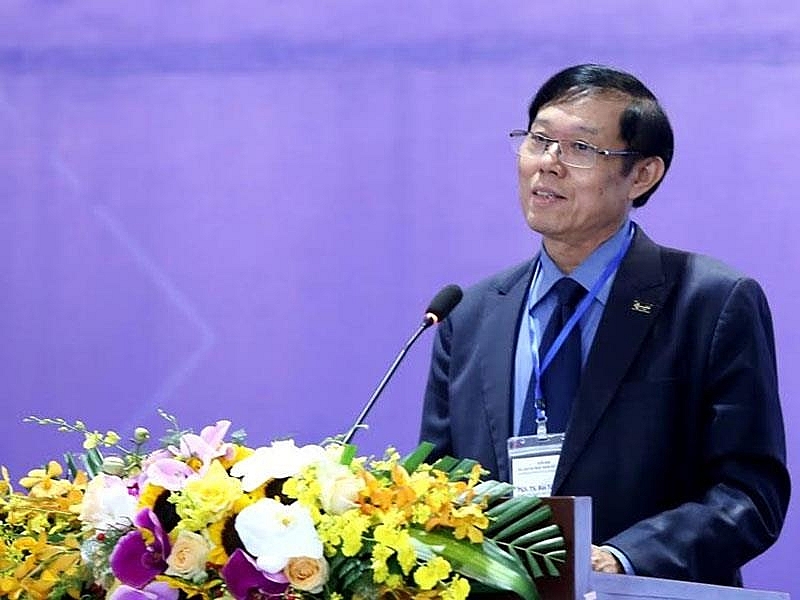VRDF 2019: six development orientations for Vietnam's prosperity
 |
| Bui Tat Thang, former president, Vietnam Institute for Development Strategies, Ministry of Planning and Investment, outlined the six major orientations |
To realise Vietnam's aspirations of becoming a prosperous nation outlined in 2016, at Vietam Reform and Development Forum (VRDF) 2019, Bui Tat Thang, former president of Vietnam Institute for Development Strategies (Ministry of Planning and Investment) clarified six major development orientations for the next 10-15 years. The orientations basically revolve around identifying and implementing strategic breakthroughs, formulating major policies aimed at exploring growth drivers, improving labour productivity and competitiveness, and effectively implementing international commitments related to integration as well as the United Nations Sustainable Development Goals for 2030.
At present, Vietnam is striving to realise the objectives to become an industrial and upper-middle-income country; to develop mature economic institutions in line with the common standards of an internationally-integrated, modern market economy; to elevate labour productivity and competitiveness; to promote harmony between economic growth and cultural and human development, social progress, and equity; and to ensure social security, environmental protection, and the sustainable development of society.
Accordingly, Vietnam needs to improve the quality of the socialist-oriented market economy institution, re-configuring the relationship between the state, the market, and society via completing the transition to an internationally-integrated, modern market economy in line with international practices, while simultaneously building a socialist state governed by the rule of law, ensuring the sufficient and timely provision of public services for the people and enterprises.
Vietnam further promotes economic restructuring to quickly establish the new growth model. Notably, the country should continue the implementation of the three initial stages of economic restructuring, namely investment restructuring (with a focus on public investment), financial market restructuring (with a focus on commercial banks and financial organisations), and the restructuring of state-owned enterprises (with a focus on state-owned economic groups and general corporations).
The third orientation is strongly developing science, technology, and innovation to take their place as the principal drivers of the new growth model. Accordingly, it is necessary to select a number of key industries and areas to be the focus of the support for the development and application of technologies.
Besides, Vietnam should enhance domestic scientific and technological capabilities, especially in digital technology, information technology, AI, electronic mechanics, automation, among others.
Two other important orientations are developing the infrastructure and urban networks, while promoting human, cultural, and social development.
Last but not least, Vietnam needs to pay attention to protecting the environment, effectively using natural resources, and responding to climate change. Accordingly, authorities will have to raise awareness and promote education on environmental protection with the philosophy that human beings are an organic part of their living environment and encourage projects with green, clean, and environmentally friendly technologies. Especially, strictly implementing the policy on environmental impact assessment for investment projects is considered one of the first priorities in this orientation.
What the stars mean:
★ Poor ★ ★ Promising ★★★ Good ★★★★ Very good ★★★★★ Exceptional
Related Contents
Latest News
More News
- Ho Chi Minh City hits $8.37 billion in FDI (December 29, 2025 | 08:28)
- Tax sector wraps up 2025 and sets priorities for next year (December 25, 2025 | 14:00)
- Heavy industries set for pilot greenhouse gas quotas (December 25, 2025 | 10:00)
- $250 million deal targets women-owned SMEs, sustainable agriculture (December 22, 2025 | 17:40)
- UOB sees Vietnam growth easing in fourth quarter (December 22, 2025 | 17:39)
- Government moves to establish International Financial Centre (December 21, 2025 | 21:00)
- Vietnam's IFC to target global investment flows (December 21, 2025 | 18:00)
- Ha Tinh breaks ground on major Vingroup industrial and energy projects (December 19, 2025 | 18:24)
- EVN launches major power infrastructure projects nationwide (December 19, 2025 | 18:17)
- VAL inaugurates second production line to meet domestic animal feed demand (December 19, 2025 | 16:37)

 Tag:
Tag:


























 Mobile Version
Mobile Version